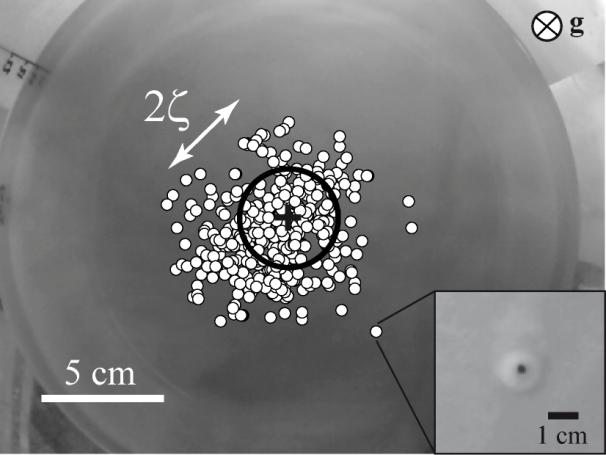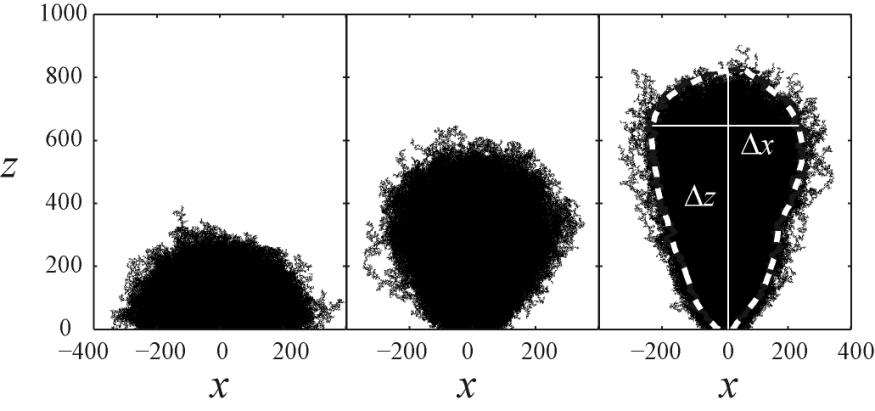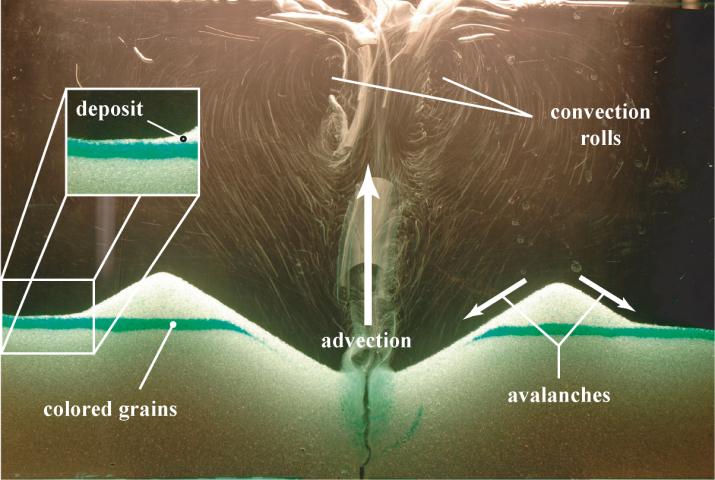Morphology and dynamics of air rise through immersed granular beds
G. Varas, J.-C. Géminard, V. Vidal
Gas or fluid venting at the surface of sediments, on the seafloor or in continental areas, is a phenomenon of huge economical and practical importance. It includes examples such as hydrothermal systems, hydrocarbure emissions, kimberlite pipes, or carbon dioxyde release – this latter being potentially responsible for the important climate changes on Earth. Its dynamics, however, still remain unconstrained, in particular in the case of three phase systems (gas, water, grains), when gas rises through the sedimentary layer.
We study this process experimentally, numerically and theoretically. When air is injected at the bottom of an immersed granular layer, it crosses the system by percolating or fracturing. It thus forms several paths that reach the free surface of the granular bed at different locations. First, we focus on the dynamics of the air invading the medium at short and long time scale, when injecting a continuous air flow. Similarly to what is observed in complex fluids, at low flow-rate, bubbles rise and burst independently one from the other (bubbling regime); at high flow-rate, an open channel connects the bottom air nozzle to the granular free surface (channeling regime); finally, at intermediate flow-rate, we observe a spontaneous alternation between the two previous regimes (intermittent regime) [1]. In a 3D experiment (cylindrical tank), we characterized the gas emission distribution at the surface of the immersed granular layer. In a 2D experiment (Hele-Shaw cell), we analyzed the paths explored by the gas rising through the system. A simple analytical model can explain, at long times, the geometry of the fluidized zone as a diffusion phenomenon [2,3].
 Bubble emission location at the free surface of an immersed granular layer (white circles and zoom).
Bubble emission location at the free surface of an immersed granular layer (white circles and zoom).
The circle of radius ζ is the characteristic size of the distribution
(50% of the bubbles are emitted inside this circle).
We also investigate the morphology of the invasion zone when injecting a constant volume of air inside the system. Numerical simulations show that the typical height and width of the region explored by the air does not depend on the injected volume only, but also on a dimensionless parameter χ which accounts for the relative effects of gravity and capillarity [4,6]. From numerical results, it is possible to define an effective diffusion coefficient which predicts the size of the invasion zone.
 Geometry of the region explored by a finite volume of air,
Geometry of the region explored by a finite volume of air,
depending on the parameter χ
(from left to right, χ= ∞, 250 and 100).
When increasing the water height above the granular layer, we observe the formation of a crater, due to successive grain advection and deposition. This crater consists of two dunes symmetric respect to the gas injection point, growing and moving away from the center. We observe that the typical size of the crater increases logarithmically with time [5]. Contrary to the intuition, we show that the crater formation dynamics does not depend on the gas emission regime.
 Dynamics of crater formation.
Dynamics of crater formation.
[1] V. Vidal, G. Varas & J.-C. Géminard,
Dynamique de dégazage dans un milieu granulaire immergé : différents aspects,
Compte-rendus de la 13e Rencontre du Non-Linéaire, Eds. C. Josserand, M. Lefranc & C. Letellier, Non-Linéaire Publications, p.199-204 (2010).
[2] G. Varas, V. Vidal & J.-C. Géminard,
Venting dynamics of an immersed granular layer,
Phys. Rev. E 83, 011302 (2011).
[3] V. Vidal, G. Varas & J.-C. Géminard,
"Venting" dans un milieu granulaire immergé,
Compte-rendus de la 14e Rencontre du Non-Linéaire, Eds. C. Josserand, M. Lefranc & C. Letellier, Non-Linéaire Publications, p.175-180 (2011).
[4] G. Varas, V. Vidal & J.-C. Géminard,
Morphology of air invasion in an immersed granular layer,
Phys. Rev. E 83, 061302 (2011).
[5] G. Varas, V. Vidal & J.-C. Géminard,
Dynamics of crater formations in immersed granular materials,
Phys. Rev. E 79, 021301 (2009).
[6] G. Varas, J.-C. Géminard and V. Vidal,
Air invasion in a granular layer immersed in a fluid: Morphology and dynamics,
Gran. Matt. DOI 10.1007/s10035-013-0435-7 (2013).




